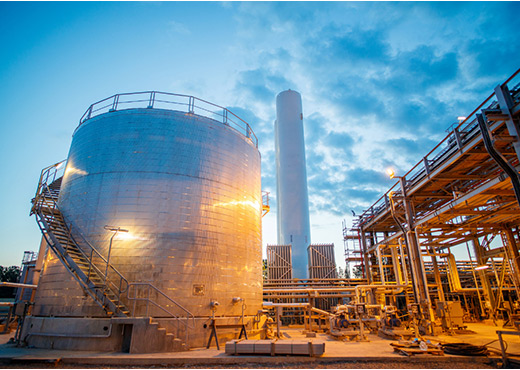Small and medium-sized enterprises (SMEs) are the backbone of South-east Asian economies. They account for 89 to 99 per cent of the total count of establishments in the region and contribute anything between 30 and 53 per cent of each country’s gross domestic product.
Any reduction of greenhouse gases from SMEs will therefore have a major impact on the total ecosystem. But decarbonisation is a complex process that requires new investments and skill sets, and SMEs must start their journey early to assess the options available for their decarbonisation.
Spurring energy transition
Much of the effort expended so far to address climate change has focused on investments in renewable energy such as solar, wind and geothermal. However, investments in renewables take time to achieve the scale and level of efficiency needed for longer term commercial viability. While the urgent push to increase renewables in the energy mix continues, it is also critical to take a parallel track to help carbon-intensive industries move towards a lower carbon future.
Industries such as oil and gas, metals and mining, fossil fuels, power generation and transportation are heavily reliant on fossil fuels. In South-east Asia, these four major industries’ account for more than 80 per cent of total emissions, compared to only about half globally. Unlike western countries whose wealth have afforded their transition into cleaner energy earlier, a fast-growing developing South-east Asian region remains heavily reliant on fossil fuels.
Given these economies’ lower starting points compared to developed economies, there is greater urgency for their companies to decarbonise. It becomes even more acute as climate change looms larger with each passing year.
Yet, green financing is not readily available to companies in the carbon intensive industries by virtue of their DNA or heredity. The lack of green financing for these carbon-intensive industries is hindering their much-needed shift towards a cleaner future.
Coming into the picture to help these companies is transition finance, an important financial tool to support their energy transition that will contribute to the overall reduction of GHG emission.
Companies will require substantial amounts of capital to bring about these changes. The Asian Development Bank estimates that some US$210 billion of investments are required every year until 2030 for climate change-adjusted infrastructure in the South-east Asian region.
In raising transition financing for projects, companies must be prepared to share a climate transition plan with the lender and relevant agencies, and how they would reach net zero emissions. The transition plan must have clearly defined timelines and a science-based de-carbonisation reduction pathway.
Decarbonisation activities supported by transition finance can take different shapes and forms. Companies can consider near-term facility upgrades to generate a higher level of operational efficiency. Other measures include the supply or purchase of biofuels to lower the carbon content in the products they manufacture, for example sustainable aviation fuel or undertake a business transformation to provide or consume renewable energy.
In the medium term, companies can shift their activities to invest in or support carbon capture utilisation or storage technology, or pivot to alternative new near-zero emission fuel technologies such as green hydrogen or ammonia.
Supporting SMEs
Setting up a transition plan is not a simple process and undertaking some of the decarbonisation activities will not be a simple flick of a switch for SMEs and hence there is great impetus for them to start doing so earlier. At the same time, help from various stakeholders is required to spur the transition for these SMEs.
Banks have a role to play in ensuring transition finance is available for carbon-intensive industries, and at the same time, to complement investments in renewable energy. Net zero emissions ambition can thus be achieved while ensuring the stability of energy supplies. This financial support will encourage carbon-intensive businesses to begin implementing long-term climate transition plans.
Financial institutions must support the energy transition by providing clear guidance. They must share know-how beyond financing, assist in building knowledge in climate transition planning, reporting and sharing best practices across the ecosystem in transition financing.
Multinational corporations, state-owned enterprises and large corporations are among the most well-resourced to lead the energy transition. They will require their ecosystem, such as their suppliers, to provide lower carbon source materials or distributors to deliver lower carbon end products. They set the overall direction and pace for smaller companies in the supply chain to de-carbonise and have a responsibility to help their supply chain to cut the overall GHG emissions.
The corporate sector’s success in energy transition lies in the commitment of multiple stakeholders to engage and reach their net zero emission goals.
Governments need to put in place the regulations and incentives such as tax incentives or even public funding to spur investments in new technologies to aid companies in the carbon intensive industries to decarbonise in alignment with their national net zero emission commitments while balancing socio-economic goals.
Consumers must be willing to bear a portion of the higher costs that will likely arise from development and adoption of new technologies.
Private companies should plan early for their transition journey and translate them into action. They need to seriously consider their GHG reduction pathways and invest in lower carbon businesses. The talent pool currently employed in carbon-intensive sectors can be re-trained for low carbon energy employment.
The top management of small and medium-sized enterprises (SMEs) must recognise sustainability as a high priority and relevant to their business even as surveys show SMEs prioritising growth and survival as critical in the post-pandemic period.
Speaking at a fireside chat at the Singapore Week of Innovation and Technology (Switch) 2022 event held at Resorts World Convention Centre on Wednesday, Transport Minister and Minister-in-charge of Trade Relations S. Iswaran said the road to sustainability for SMEs starts with their top management.
“Making the decision to make sustainability a priority has to come from the top – if it starts from the employees, they may not see the point of doing it as they don’t know if it will be appreciated by their bosses,” said Mr Iswaran.
Small companies must also assess their environmental footprint and decide which aspect to focus on to become greener, he added.
His comments come amid mounting feedback from local firms about the challenges of implementing sustainable practices.
An annual business survey by the Singapore Chinese Chamber of Commerce and Industry (SCCCI) showed that the top three challenges that hinder sustainability efforts by SMEs are the high costs involved, the priority on business survival and a lack of capabilities and resources to understand and implement relevant sustainability practices.
The survey results, which were released on Monday, also showed that 70.8 per cent of the respondents regarded sustainability as important to their businesses to a moderate or large extent.
But most of the respondents, which comprised senior representatives of local businesses across diverse sectors, had incorporated sustainability into their businesses only to a moderate extent.
SMEs accounted for 91 per cent of the 1,057 respondents of the survey, which was conducted from May 30 to Aug 12.
A separate survey of 800 SMEs across six markets in Asia found that eight in 10 SMEs in Singapore rate environmental, social and governance (ESG) as a high priority for their business.
SMEs acknowledge the need for more sustainable business models but are struggling to put their transition plans in place, said Ms Joyce Tee, group head of SME banking at DBS. “This is because the post-pandemic economic environment has meant that business growth and survival are top of mind.”
The survey was conducted by DBS and Bloomberg Media Studios in August.
Although business sentiments have improved compared with last year, businesses have to grapple with manpower shortage, inflationary pressures, rising interest rates and geopolitical risks, said SCCCI president Kho Choon Keng. “Despite these challenges, SMEs must continue to transform, innovate, digitalise, explore growth opportunities overseas and embrace sustainability.”
By applying technologies to create new products and services, resolve existing issues, these startups can make a significant contribution to economic development while at the same time generating social and environmental benefits.
But to survive and thrive, technology startups require an enabling ecosystem that includes supportive government policy, easy access to capital, skilled personnel, quality digital infrastructure, and several other elements.
The Cambodian technology startup ecosystem is developing rapidly as private support for new ideas and innovations from incubators, local angel investors, private equity (PEs), and venture capital funds is widening. Over 300 technology startups are in the various stages of development.
Higher education institutions have begun to focus on promoting entrepreneurship and innovation, with some universities setting up their own incubation and startup centers as well as industry linkage offices.
The enactment of laws, like the Consumer Protection Law, the E-Commerce Law, and the Competition Law, has helped in creating more favourable conditions for entrepreneurship and risk-taking.
However, the National Innovation System of Cambodia is still underdeveloped. Cambodia ranked 101 out of 127 countries in the 2018 Global Innovation Index. It scored particularly low in terms of expenditure on education, tertiary enrolment, and knowledge-intensive employment.
While the new government structure for promoting STI can provide a strong basis for the development of the Cambodian National Innovation System, collaboration among stakeholders (within the government and between the government institutions, the private sector, and the academia) is currently weak. The diffused responsibility for science and technology across 11 key ministries presents challenges for effective policy development and governance, and the mandate of MISTI (Ministry of Industry, Science, Technology and Innovation) as the main coordinating institution is still to be consolidated.
Vongsey Vissoth, Minister attached to the Prime Minister, Permanent Secretary of State of the Ministry of Economy and Finance, and Chairman of the Entrepreneurship Development Fund, gave an engaging presentation on the SMEs (small and medium enterprises) and entrepreneurship ecosystem and said it would take public and private sector collaboration to uplift Cambodia’s SMEs.
“Cambodian entrepreneurs have provided support to nearly 400 new businesses and nurtured a youth entrepreneurial culture in target provinces across the country through capacity building, business networking and marketing, and business competition programmes through funding startups as well,” Vongsey Vissoth said.
For full article, please read here
Author: Sok Sithika
Source: Khmer Times
Cambodia is at crossroads on many fronts, starting with its graduation from the least developed country (LDC) status to post-pandemic economic recovery, according to the latest UNDP research.
The country has drafted the Power Development Plan (2021–40) to respond to the anticipated power demand. It was based on the principles of affordability of electricity supply by embracing least cost generation mix and reliability with adequate generation and transmission.
As ASEAN countries are looking for energy security through greater use of domestic resources, countries such as Cambodia are increasing external sources, including the import of electricity from neighbouring countries.
The government could work out a plan even to shift investment from coal towards renewable and avoid externality costs and potentially stranded assets.
Tassilo Brinzer, Chairman of the European Chamber of Commerce in Cambodia, said, “The Royal Government’s full approval and support for the use of solar panels on roofs is a significant step. Cambodia has gained a reputation as a green and more competitive environment, as well as for better integration into the regional economy.”
Brinzer said it would push Cambodia to become an investment destination as investing in renewable energy can be supported as a qualified investment project under the new investment law and attract producers with clean energy goals.
Yet Cambodia has an opportunity to go beyond its renewable energy strategies and benefit from its unique location between the two leading Greater Mekong sub-region economies and position itself as a leader in green business, the report said. It would enable the Cambodian industry to better integrate into fast, modern, sustainable regional supply chains, it added.
One of the other major benefits, in addition to reducing carbon emissions, is the potential for creating new industries that guarantee a better sustainable energy future, led by the development of solar technology.
For full article, please read here
Author: Sok Sithika
Source: Khmer Times
The cooperation is expected to enhance energy security and sustainability in the region.
The MoU was signed virtually yesterday by Suy Sem, Minister of Mines and Energy, and Tan See Leng, Minister for Manpower and Second Minister for Trade and Industry of Singapore.
The two sides agreed in principle to develop the transitional energy infrastructure and increase energy connectivity opportunities in ASEAN to enhance energy security and sustainability, said Heng Kunleang, director-general of the ministry’s energy department.
This cooperation is beneficial and a step towards the vision of ASEAN energy connectivity, in which the two countries are like-minded partners, taking into account common interests and common goals towards cleaner and more energy-efficient sources and towards zero emissions at or between the middle of the century, Kunleang told Khmer Times yesterday.
“Today’s Memorandum of Understanding reflects the two countries’ strong commitment to deepening energy partnerships to promote the use of renewable energy and the development of the ASEAN power grid and electricity interconnection for cross-border electricity trade to build more economic sustainability towards a common low-carbon future, as well as to achieve the ASEAN energy interconnected vision,” Kunleang said.
For full article, please read here
Author: Chea Vanyuth
Source: Khmer Times
The ceremony of the Vietnam-Australia Business Champions Initiative took place in Hanoi on the morning of October 18 in the presence of the Deputy Minister of Planning and Investment Tran Duy Dong and the Australian Assistant Minister for Trade and Manufacturing Tim Ayres, as well as some Australian and Vietnamese enterprises.
Tran Duy Dong underlined that, after a year of executing the project, pioneering entrepreneurs in Vietnam and Australia have engaged in several important activities, therefore generating significant value for the business communities of the two nations. “Before today's event, I also had a brief conversation with pioneer entrepreneurs, and I admired their aggressive, passionate, and enthusiastic attitude, as well as the positive early results produced over the past year,” Dong stressed.
Australian Assistant Minister for Trade and Manufacturing Tim Ayres also acknowledged the brief but productive discussion with six leading entrepreneurs. “Deputy Minister Tran Duy Dong and I sat with the pioneer entrepreneurs of the two nations, listened to their many excellent proposals, and will take concrete steps to expand prospects for investment, exporters, and importers of the two countries.”
Both parties reaffirmed their resolve to continue fostering advantageous investment and trade arrangements between the two nations. The Vietnamese side emphasised that it will remove barriers to market entry, import-export procedures, and land, while the Australian side expressed support for pioneering businesses' investment plans. According to Dong, this is a significant and meaningful event that celebrates the efforts and positive achievements of Vietnamese-Australian pioneering businesses over the previous year to boost effective trade and investment relations between the two nations.
Both are certain that the two nations will achieve their aim of being one of the top 10 trade partners of each other and achieving a twofold increase in two-way investment. Six pioneering entrepreneurs from Vietnam and Australia have been selected as senior, experienced executives from prominent enterprises and corporations in critical sectors of the agricultural economy; industrial production; mining; steel manufacturing of steel; technological solutions; and banking and education by the authorities of the two nations.
These are entrepreneurs from TH Group, Hoa Phat Group, Vietcombank, Aurecon Group, Sunrice Group, RMIT University, and Bean Centre.
In both countries, the Business Champions have already been active. The Australian Business Champions convened over one hundred business and government leaders for a series of roundtables in five Australian states and one territory. The Vietnamese Business Champions have formed a business network, co-chaired a roundtable with more than one hundred enterprises in attendance, and participated in high-level government discussions.
In August 2019, the prime ministers of Australia and Vietnam agreed to construct an Enhanced Economic Engagement Strategy, with the goals of becoming one of the top 10 trading partners and tripling bilateral investment. The Business Champions were selected based on their stellar reputation and their representation of important sectors for the economic cooperation between Australia and Vietnam. Their duty is to promote Australia-Vietnam trade and investment, encourage interaction with industry, and report back to governments on both commercial possibilities and problems.
Source : VIR
The Cambodian delegation started their visit touring the 37th Trade Expo Indonesia in Baten province which was attended by Indonesian President Joko Widodo and Zulkifli Hasan, Minister of Trade. More than 1,000 guests from over 100 countries congregated at the Indonesia Convention Exhibition Centre (ICE).
The opening ceremony started with an Indonesian traditional dance followed by a fashion show at the ICE on Wednesday morning. Various products were displayed at more than 1,000 booths.
In his opening address at the 37th Trade Expo Indonesia, Indonesian President Joko Widodo said that the growth of the Gross Domestic Product (GDP) of Indonesia has grown 5.44 percent in the second quarter of 2022 even though the inflation has risen to about 5 percent in the same period, while the country’s central bank Bank Indonesia and municipal-provincial authorities have worked together to control the inflation effectively.
Lauti Nia Astri, Minister Counsellor of Economic Cooperation of the Embassy of Indonesia in Cambodia, told Khmer Times that when the trade mission started the off-line trade mission has not been arranged for two years – 2020 and 2021 – due to the Covid-19 pandemic around the world, while the trade exhibition had still been organised on line.
“We expect the delegations or businesspeople will find what they are looking for as there are many varieties of products here from food & beverage, lifestyle products, pharmaceuticals, cosmetics to everything,” Nia Astri said, adding that it is expected that more than 1,000 buyers from across world such as Egypt, South Africa and Senegal to participate in the exhibition.
For full article, please read here
Author: Kang Sothear
Source: Khmer Time
Strong growth was reported in the manufacturing of petrochemical products in Q1 2022, and the start of Brunei Fertilizer Industries’ ammonia and urea production is forecast to increase revenue in the downstream sector.
Source: The Scoop
Read the full article here
The Sultanate ranked first globally in cost of redundancy dismissal, second globally in applied tariff rate, third in political and operational stability, fourth in pupil-teacher ratio and in graduates in science and engineering.
This was revealed in the recently-published 2022 Global Innovation Index (GII). Brunei Darussalam was 47th among the 48 high-income group economies.
The Sultanate is in 38th place in global corporate R&D investors, but did not score well in domestic industry diversification, hi-tech manufacturing and infocommunications technology services exports indicators.
Brunei ranked 14th among the 17 economies in the Southeast Asia, East Asia, and Oceania (SEAO) region.
The institutions category is where the Sultanate performed the best, at 23rd place globally.
In benchmarking against other high-income economies, Brunei Darussalam performed above the group average, while in the SEAO region, the Sultanate performed above the regional average.
Meanwhile, Brunei ranked 53rd in human capital and research and 61st in infrastructure. Its weakest performance was in knowledge and technology outputs (127th).
Source: Borneo Bulletin
Read the full article here
The ASEAN+3 Macroeconomic Research Office (AMRO) last week revised downwards Brunei Darussalam’s economic growth from 3.0 per cent forecast in July to 0.7 per cent in its October Economic Outlook.
As for next year’s gross domestic product (GDP) growth, it also revised the Sultanate’s growth from 3.9 per cent projected in July to 3.0 per cent in its October update.
AMRO also revised its short-term growth forecast for the ASEAN+3 region.
The continuing strict dynamic zero-COVID policy and real estate sector weakness in China and potential recessions in the United States (US) and the euro area are weighing on the region’s outlook.
In its October Update, AMRO staff forecasted the ASEAN+3 region to grow by 3.7 per cent this year – down from the 4.3 per cent growth projected in July reflecting mainly weaker growth in Plus-3 economies.
The ASEAN region is expected to grow strongly by 5.3 per cent. The region’s inflation rate for 2022 is now projected to be 6.2 per cent – a full percentage point higher than previously forecast. Growth is expected to increase to 4.6 per cent in 2023 as China’s economy picks up, with inflation moderating to about 3.4 per cent.
Source: Borneo Bulletin
Read the full article here
























